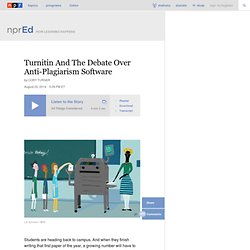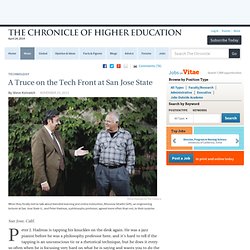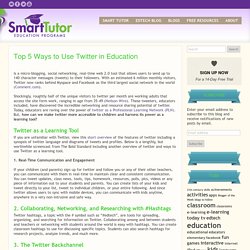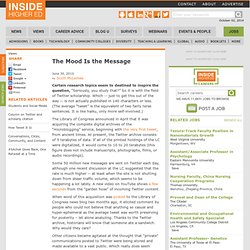

The Open Publishing Revolution, Now Behind A Billion-Dollar Paywall. In 2013, when Victor Henning announced that his startup Mendeley would be acquired by one of the world's biggest media companies, he knew there would be blowback.

He just couldn't have anticipated how bad it would get. "Seeing that some of our most vocal advocates thought we had sold them out felt awful," he says over a tea in Amsterdam, where Elsevier, Mendeley's parent company, is headquartered. Launched in 2007 by Henning and two friends at graduate school, Mendeley built an unlikely but very useful piece of software—think a variation on Evernote combined with Facebook—aimed at helping researchers organize their papers, annotate them, and share them with each other. It swiftly took the academic world by storm. Researchers loved the ability to search for and in some cases access papers from journals they didn't subscribe to—a small protest against the billion-dollar industry that critics insist serves as a gatekeeper to the world’s scientific findings.
Faculty Views on Digital Courseware. Responding to Offensive Posts on Yik Yak, Professors Stage Social-Media Takeover. Turnitin And The Debate Over Anti-Plagiarism Software : NPR Ed. Students are heading back to campus.

And when they finish writing that first paper of the year, a growing number will have to do something their parents never did: run their work through anti-plagiarism software. One company behind it is called Turnitin. And the database it uses to screen for potential plagiarism is big. Really, really big. Chris Harrick, Turnitin's vice president of marketing, describes it this way: "Automatically, that paper gets checked against about 45 billion web pages; 110 million content items from publishers, scientific journals, et cetera; and 400 million student papers to provide an originality report. " A Truce Over Technology. San Jose, Calif.

Peter J. Hadreas is tapping his knuckles on the desk again. He was a jazz pianist before he was a philosophy professor here, and it's hard to tell if the tapping is an unconscious tic or a rhetorical technique, but he does it every so often when he is focusing very hard on what he is saying and wants you to do the same. "To have somebody in front of you whom you really believe is going to try to find the truth of things even if it goes against the group—to see somebody like that is as powerful as learning what ad hominem and half-fallacies are," he tells us. "I don't think the screen can do that. " He's talking about online education, of course—a high-profile issue here at the San Jose State University, where Mr.
The man sitting across from Mr. Angered by MOOC Deals, San Jose State Faculty Senate Considers Rebuff. Mohammad H.

Qayoumi, president of San Jose State University, has spent much of the year turning his campus into a testing ground for new online-teaching tools. Coursera Snags $43-Million in Venture Capital - Wired Campus. The jury may still be out on how much money massive open online courses stand to generate for the companies and universities that offer them, but that has not deterred investors from betting big on Coursera, the largest MOOC company.

The company announced on Wednesday that it had raised $43-million in its second round of financing, adding to the $22-million it raised last year. The announcement came several months after Coursera started collecting revenue from students paying to take proctored examinations through the company’s “Signature Track” program. The program has generated more than $800,000 since January, a portion of which has gone to the universities that offered the Signature Track MOOCs on the Coursera platform.
Most Professors Use Social Media - Wired Campus - The Chronicle. Teaching About the Web Includes Troublesome Parts. And they did.

But to his dismay, some of his students posted surveys like “Who’s the most popular classmate?” And “Who’s the best-liked?” Mr. "Twitter in the Classroom" section of the ToC - Twitter for Teac. The Future of Reading - In Web Age, Library Job Gets Update - Se. Top 5 Ways to Use Twitter in the Classroom. Is a micro-blogging, social networking, real-time web 2.0 tool that allows users to send up to 140 character messages (tweets) to their followers.

With an estimated 6 million monthly visitors, Twitter now ranks behind Myspace and Facebook as the third largest social network in the world (Comment.com). Shockingly, roughtly half of the unique visitors to twitter per month are working adults that access the site form work, ranging in age from 35-49 (Neilson Wire).
These tweeters, educators included, have discovered the incredible networking and resource sharing potential of twitter. Today, educators are raving over the power of twitter as a Professional Learning Network (PLN). But, how can we make twitter more accessible to children and harness its power as a learning tool? Twitter as a Learning Tool If you are unfamiliar with Twitter, view this short overview of the features of twitter including a synopsis of twitter language and diagrams of tweets and profiles.
Education - Central Elementary School Profile. 10 New Education Companies to Watch (Plus 3 More for Extra Credi. W8: Social Media Summit II - Higher Ed, Social Media, and the La. Views: The Mood Is the Message. Certain research topics seem to destined to inspire the question, “Seriously, you study that?”

Twitter for Academia - academhack - Thoughts on Emerging Media a.